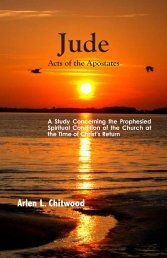Signs in John's Gospel - The Lamp Broadcast
Signs in John's Gospel - The Lamp Broadcast
Signs in John's Gospel - The Lamp Broadcast
Create successful ePaper yourself
Turn your PDF publications into a flip-book with our unique Google optimized e-Paper software.
80 SIGNS IN JOHN’S GOSPEL<br />
and the Sea toward another land.<br />
(For additional <strong>in</strong>formation on John 3:5 and the typology of the<br />
Red Sea passage, refer to Ch. VIII, pp. 93-98, <strong>in</strong> this book. Also refer to<br />
the author’s book, REDEEMED FOR A PURPOSE, Ch. IX, pp. 126-129.)<br />
John 1:11-13 deals with the child-tra<strong>in</strong><strong>in</strong>g of disobedient sons,<br />
and John 3:3-8 deals with particulars surround<strong>in</strong>g this child-tra<strong>in</strong><strong>in</strong>g.<br />
A deliverance of saved <strong>in</strong>dividuals, a deliverance with regality <strong>in</strong><br />
view, is seen throughout.<br />
James<br />
James 1:15-18 shows a begett<strong>in</strong>g, a br<strong>in</strong>g<strong>in</strong>g forth from both<br />
below and above. Verse fifteen shows the former (from below), and<br />
verse eighteen the latter (from above).<br />
In verse fifteen, the Greek words tikto (“to beget,” “to br<strong>in</strong>g<br />
forth”) and apokueo (“to br<strong>in</strong>g forth,” “to give birth [as seen <strong>in</strong><br />
a medical respect]”) are used <strong>in</strong> a somewhat synonymous sense,<br />
with apokueo show<strong>in</strong>g “results.” Tikto is used <strong>in</strong> the first part of<br />
the verse (“br<strong>in</strong>geth forth s<strong>in</strong>”); and apokueo is used <strong>in</strong> the latter<br />
part of the verse show<strong>in</strong>g the results, <strong>in</strong> the sense of “s<strong>in</strong>” hav<strong>in</strong>g<br />
given birth to (“br<strong>in</strong>geth forth death”).<br />
<strong>The</strong>n <strong>in</strong> verse eighteen, apokueo is used relative to life <strong>in</strong>stead<br />
of death, as seen <strong>in</strong> verse fifteen. And this word is used relative<br />
to the power of the Word <strong>in</strong> a Christian’s life, effect<strong>in</strong>g, giv<strong>in</strong>g birth to,<br />
the metamorphosis — the results of the power of the Word (ref. the<br />
author’s book, SALVATION OF THE SOUL, Ch. IV):<br />
“Of his own will begat he us with the Word of truth…”<br />
Thus, these two words are used <strong>in</strong> James relative to Christians<br />
either be<strong>in</strong>g brought forth from below (through that associated<br />
with s<strong>in</strong>, result<strong>in</strong>g <strong>in</strong> death) or be<strong>in</strong>g brought forth from above<br />
(through the Word, result<strong>in</strong>g <strong>in</strong> life).<br />
I Peter<br />
God br<strong>in</strong>g<strong>in</strong>g <strong>in</strong>dividuals forth <strong>in</strong> I Peter 1:3, 23 has to do with<br />
additional commentary on that seen <strong>in</strong> John 3:3-8. But, rather than



